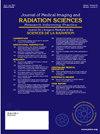人工智能图像分析和定量
IF 1.3
Q3 RADIOLOGY, NUCLEAR MEDICINE & MEDICAL IMAGING
Journal of Medical Imaging and Radiation Sciences
Pub Date : 2024-10-01
DOI:10.1016/j.jmir.2024.101468
引用次数: 0
摘要
人工智能(AI)通过实现先进的图像分析和量化技术,为包括医学成像在内的医疗保健各个领域带来了革命性的变化。本讲座将深入探讨人工智能在放射摄影和放射技术中的分割、图像配准和图像生物标记推导方面的应用现状和未来前景。分割是将图像分割成有意义区域的过程,在医学图像分析中起着举足轻重的作用。人工智能驱动的分割算法,如基于深度学习的方法,在准确划分医学图像中的解剖结构和病理区域方面表现出色。这些技术有望提高诊断准确性、改善治疗规划和患者预后。图像配准是将多幅图像对准一个共同的坐标系,对于图像融合、运动校正和治疗规划等各种医学成像任务至关重要。基于人工智能的配准方法利用机器学习算法来实现稳健而准确的图像配准,即使存在复杂的变形和解剖变化也不例外。这些进步促进了多模态成像数据的整合,并增强了临床决策能力。图像生物标志物是从医学图像中提取的定量指标,对疾病特征描述、治疗反应评估和预后评价至关重要。人工智能图像分析技术能够从医学影像中提取复杂的生物标志物,为临床医生提供有关疾病进展和疗效的宝贵见解。此外,基于人工智能的预测模型可利用图像中的生物标志物预测患者的预后并指导个性化治疗策略。本讲座将探讨当前人工智能驱动的图像分析和量化的最先进技术,并讨论将这些技术转化为临床实践的挑战和机遇。总之,人工智能在彻底改变放射学和放射技术中的图像分析和量化方面潜力巨大,为提高诊断准确性、改善患者护理和推进该领域的研究提供了前所未有的机遇。通过采用人工智能驱动的方法,放射技师和放射技术专家可以利用技术的力量优化医疗服务,改善全球患者的治疗效果。本文章由计算机程序翻译,如有差异,请以英文原文为准。
AI Image Analysis and Quantification
Artificial Intelligence (AI) has revolutionized various fields of healthcare, including medical imaging, by enabling advanced image analysis and quantification techniques. This presentation delves into the current landscape and future prospects of AI application in segmentation, image registration, and the derivation of image biomarkers in radiography and radiological technology. Segmentation, the process of partitioning an image into meaningful regions, plays a pivotal role in medical image analysis. AI-driven segmentation algorithms, such as deep learning-based approaches, have demonstrated remarkable performance in accurately delineating anatomical structures and pathological regions from medical images. These techniques hold promise for improving diagnostic accuracy, treatment planning, and patient outcomes. Image registration, the alignment of multiple images to a common coordinate system, is essential for various medical imaging tasks, including image fusion, motion correction, and treatment planning. AI-based registration methods leverage machine learning algorithms to achieve robust and accurate image alignment, even in the presence of complex deformations and anatomical variations. These advancements facilitate the integration of multi-modal imaging data and enhance clinical decision-making. The derivation of image biomarkers, quantitative measures extracted from medical images, is crucial for disease characterization, treatment response assessment, and prognostic evaluation. AI-enabled image analysis techniques enable the extraction of sophisticated biomarkers from medical images, providing clinicians with valuable insights into disease progression and therapeutic efficacy. Moreover, AI-based predictive models leverage image-derived biomarkers to forecast patient outcomes and guide personalized treatment strategies. This presentation will explore the current state-of-the-art in AI-driven image analysis and quantification and discuss the challenges and opportunities in translating these technologies into clinical practice. In conclusion, AI holds tremendous potential to revolutionize image analysis and quantification in radiography and radiological technology, offering unprecedented opportunities for enhancing diagnostic accuracy, improving patient care, and advancing research in the field. By embracing AI-driven approaches, radiographers and radiological technologists can leverage the power of technology to optimize healthcare delivery and improve outcomes for patients worldwide.
求助全文
通过发布文献求助,成功后即可免费获取论文全文。
去求助
来源期刊

Journal of Medical Imaging and Radiation Sciences
RADIOLOGY, NUCLEAR MEDICINE & MEDICAL IMAGING-
CiteScore
2.30
自引率
11.10%
发文量
231
审稿时长
53 days
期刊介绍:
Journal of Medical Imaging and Radiation Sciences is the official peer-reviewed journal of the Canadian Association of Medical Radiation Technologists. This journal is published four times a year and is circulated to approximately 11,000 medical radiation technologists, libraries and radiology departments throughout Canada, the United States and overseas. The Journal publishes articles on recent research, new technology and techniques, professional practices, technologists viewpoints as well as relevant book reviews.
 求助内容:
求助内容: 应助结果提醒方式:
应助结果提醒方式:


